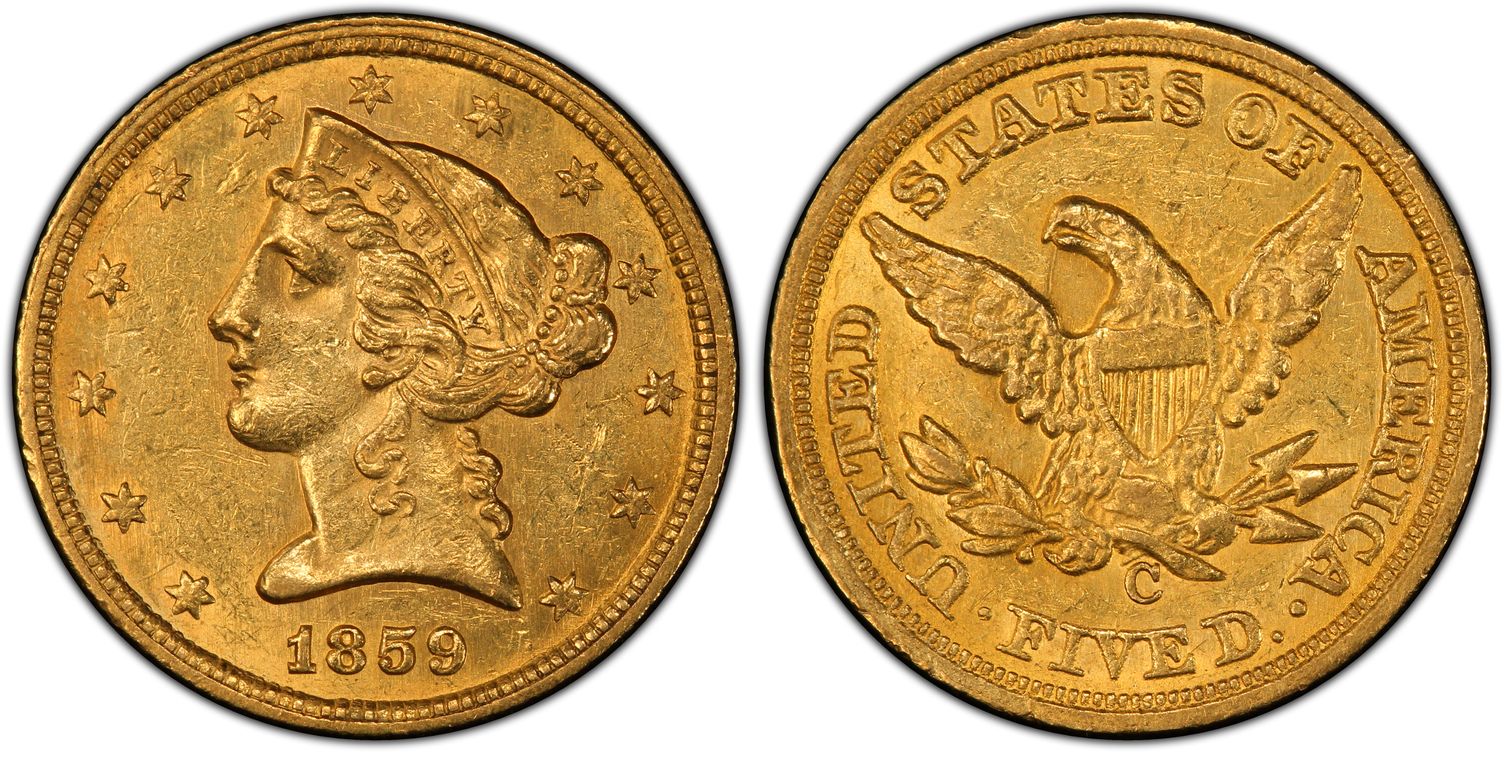1859-C $5 MS61 认证号25620224, PCGS号8281
专家评论
David Akers (1975/88)
To the best of my knowledge, all 1859-C half Eagles have a weak, indistinct reverse. In my opinion, this weakness was not a function of strike but rather is the result of problems with the dies. In fact, the obverses of most specimens I have seen have generally been well struck. Because of the reverse weakness, grading 1859-C Half Eagles is difficult and even AU or uncirculated pieces give the impression of being worn. VF or EF examples are all that are generally available but there are a few strictly uncirculated specimens known.Doug Winter
While similar to the 1857-C and the 1858-C half eagles in terms of original mintage, the 1859-C is scarcer overall and considerable rarer in high grades. In lower grades, the 1859-C is fairly easy to obtain. It becomes scarce in properly graded AU50 to AU53 and rare in the higher About Uncirculated range, with most of the coins that I have seen graded AU55 and AU58 displaying poor eye appeal. In Uncirculated, this is an extremely rare coin with just five or six known. This includes a superb MS66 Gem that is quite possibly the single finest known Charlotte half eagle of any date.STRIKE: Along with the 1860-C, the 1859-C half eagle has the most distinctive pattern of strike for any coin produced at the Charlotte Mint. It is literally a coin that can be attributed from a mile away. There is some weakness noted on the curls below BERT in LIBERTY and at the top of the curl beneath the ear. The reverse is extremely weak. A number of different reasons have been given as to why this is the case. These include an old die being used (which is incorrect as records show that the 1859-C reverse dies were shipped to Charlotte in December 1858), the reverse was improperly annealed (which would explain the lack of detail but not the presence of die rust) or that the die somehow became clogged as it was being used. Another theory states that the die may have only been hubbed once instead of twice, leaving a faint and incomplete impression. Whatever the reason, every known example has extremely weak and "fuzzy" detail. The areas that are especially weak include the neck of the eagle, the top of the shield, the left wing and the arrow feathers. Extensive areas of rust can be seen over and behind the head of the eagle, below ITED in UNITED, alongside the right leg, on the arrowheads, below the mintmark and over AMER in AMERICA.
SURFACES: As described above, the surfaces show extensive areas of die rust. In addition, many pieces are heavily abraded with deep, detracting marks visible in the fields. I have seen just a small handful that were not very heavily abraded and these are always in demand among date collectors.
LUSTER: The obverse shows fairly good luster. It is usually satiny in texture with a slightly grainy appearance. The reverse is not as lustrous due to the surface disturbances mentioned above.
COLORATION: The few original examples that exist have medium to deep orange-gold color. A few show lighter yellow-gold hues. The majority have been cleaned at one time and original examples are very rare and desirable.
EYE APPEAL: When you look at an 1859-C half eagle, you must understand that the obverse is much different than the reverse. In fact, it is almost like looking at two different coins. Some 1859-C half eagles have nice quality obverses with decent detail and good luster. Every known example has numerous mint-made problems. Because of this fact, and 1859-C must be graded by its reverse alone.
DIE CHARACTERISTICS: The primary die characteristics of this issue are mentioned above.
DIE VARIETIES: A single variety is known.
Variety 1 (formerly 27-M). The 1 in the date is slightly closer to the denticles than to the bust and the 9 is closer to the denticles than to the bust. The reverse was used in 1859 and again in 1860. The mintmark is large and the right edge is placed over the right edge of the upright of the E in FIVE. The left edge of the mintmark is over the right serif of the V. The serif of the mintmark is very close to the feathers.
Two die states are known.
DIE STATE I: The obverse is free of rust while the reverse shows light to moderate rust.
DIE STATE II: The obverse show scattered areas of rust. The rust on the reverse ranges from moderate to extensive.
PCGS #
8281
设计师
Christian Gobrecht
边缘
Reeded
直径
21.65 毫米
重量
8.36 克
铸币数量
31847
金属成分
90% Gold, 10% Copper
更高评级数量
5
评级较低的钱币数量
171
地区
The United States of America
价格指南
PCGS 数量报告
拍卖 - PCGS 评级的
拍卖 - NGC 评级的
稀有性和存量估计 了解更多
| 所有评级 | 225 |
| 60或以上 | 7 |
| 65或以上 | 1 |
| 所有评级 | R-6.7 |
| 60或以上 | R-9.6 |
| 65或以上 | R-10.0 |
| 所有评级 | 64 / 112 TIE |
| 60或以上 | 44 / 112 TIE |
| 65或以上 | 1 / 112 TIE |
| 所有评级 | 99 / 218 TIE |
| 60或以上 | 71 / 218 TIE |
| 65或以上 | 1 / 218 TIE |






















